Run
When a Project is open the Run button becomes available from the command bar.
![]()
This will display the Forms, designed in the Project Designer, in the DriveWorks Solo Task Pane.
Run - From File
A previously Run project, that has had the Form Data Exported (see Export Form Data section below), can be run again by clicking the drop down icon on the Run button and selecting From File.
![]()
This feature allows the Forms to be populated with data from:
- Similar projects run from a different machine.
- Similar projects run from a DriveWorks Pro module (that have had Specification Data Exported).
- Past versions of projects that require re-running.
When the XML file differs from what is expected the following messages will be displayed:
- The following message will be displayed when there are controls that exist in the specification file that cannot be found in the project:

Expand the More Details drop down for a detailed list of all controls that could not be driven.
Check 'Don't show this message again' to ignore further warnings until the application is restarted.
- The following message will be displayed when the XML file is not a valid specification file.
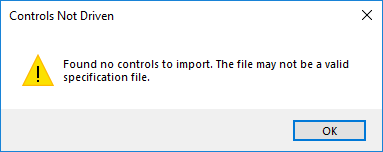
- When new controls have been added to the project, that do not exist in the XML file, the project will run with the valid controls populated.
The controls that cannot be populated will not be driven (any default values applied will be preserved).
Run - Bottom of Capture Assistant
The Run button available from the bottom of the capture assistant provides access to Local DriveWorks Solo projects.

It also provides access to sample content.

Double clicking any local project takes you straight into run mode.
Right clicking any recent project will give a menu option to either Edit Project or run the project From File.
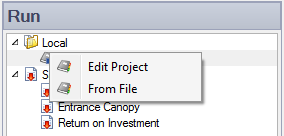
Give Access to all Local DriveWorks Solo Projects
All Projects can be run without having to open each project individually.
- Click the Run bar from the bottom of the capture assistant.

- Right click the Local folder and select Choose Folders.
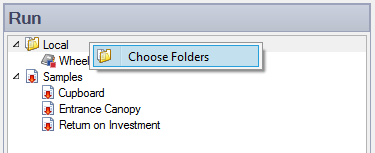
- Click Add from the Local Folders window.
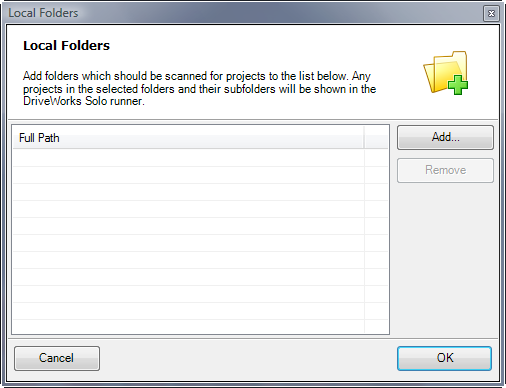
- Browse to the location the project is stored and click OK.
- Repeat steps 3 and 4 for each folder you have a project located.
Or
Select a parent location if all projects are stored relative to it.
Generating a Preview
When you run your project, the DriveWorks Solo tab changes into Running mode. Some command bar items are hidden/disabled, and new ones appear:

- Generates a preview of the model based on the current filled-in values
The Preview function loads files with a temporary name. This is to reduce load time when the specification is modified and the models previewed once more. In doing this any features or components whose rules result in Delete will be substituted with Suppress.
The drop down on the Preview button displays an option for activating Auto Preview.
Auto Preview will auto generate the SOLIDWORKS models each time a form control is updated.
- Generates a drawing attached to the top-level model (the model must have been previewed at least once before this option can be used)
- Provides previews of the documents in the project.
The area below the form changes to display navigation options, and any form warnings which were setup for input controls.
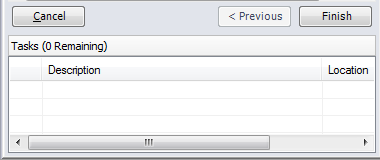
Finish
When the running project is finished by clicking on the Finish button, the following dialog is displayed:
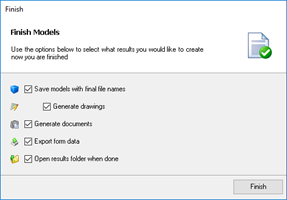
You can choose which outputs you want to generate, and also whether you want the results folder opened after generation has finished.
The output options are:
- Save models with final file names
- Selecting this option will generate all required models, in the final locations with their final file names.
- De-selecting this option will not generate any models or drawings.
- Generate drawings (Only available when Save models is selected)
Selecting this option will generate all required drawings.
- Generate documents
Selecting this option will generate all required documents.
- Export form data
Selecting this option will export all control names and values entered as an XML file. See below for more information.
- Open results folder when done
Selecting this option will launch a Windows Explorer window, in the parent location of where all the results are stored.
Export Form Data
The Export Form Data option allows you to export the names, type and values of all the controls in the forms, being run, as an XML file.
- Names are the names applied to the controls on each form.
- Type is the type of control (for example TextBox, CheckBox, etc.).
- Values are the values of the control when Finish was selected from the form.
This option will export all editable controls. The Controls that are editable are:
- Check Box
- Combo Box
- List Box
- Numeric Text Box
- Option Group
- Slider
- Spin Button
- Text Box
The name of the XML file will take the project name with the SpecificationID special variable appended to it.
The XML file will be stored in the parent Results folder.
An example of the exported XML file is shown below:
<?xml version="1.0" encoding="utf-8"?>
<Specification SpecificationName="WheelChair 0008" ProjectName="Wheelchair" SpecificationID="8">
<Controls>
<Control Name="QuoteNumber" Type="TextBox">
<Value>MB0008</Value>
</Control>
<Control Name="CompanyName" Type="TextBox">
<Value>DriveWorks Ltd</Value>
</Control>
<Control Name="ContactName" Type="TextBox">
<Value>Mr. M. Lowe</Value>
</Control>
<Control Name="Address" Type="TextBox">
<Value>UK</Value>
</Control>
<Control Name="Currency" Type="ComboBox">
<Value>US Dollar</Value>
</Control>
<Control Name="BackHeight" Type="TextBox">
<Value>524</Value>
</Control>
<Control Name="ThighLength" Type="TextBox">
<Value>426</Value>
</Control>
<Control Name="ShinLength" Type="TextBox">
<Value>415</Value>
</Control>
<Control Name="Check" Type="CheckBox">
<Value>false</Value>
</Control>
<Control Name="Wheels" Type="OptionGroup">
<Value>Sport</Value>
</Control>
<Control Name="Spokes" Type="ComboBox">
<Value>3</Value>
</Control>
</Controls>
</Specification>
- Welcome
- What's New
- DriveWorks 23
- Older Versions
- DriveWorks 22
- DriveWorks 21
- DriveWorks 20
- DriveWorks 19
- DriveWorks 18
- DriveWorks 17
- DriveWorks 16
- DriveWorks 15
- DriveWorks 14
- DriveWorks 12
- What's New DriveWorks 12
- Form Design
- Rule Builder
- Model Rules
- DriveWorks Add-in for SOLIDWORKS
- SP1
- SP2
- DriveWorks 11
- Welcome to DriveWorks Solo 11 What's New
- Capturing
- Project Designer
- Installation
- Licensing
- SP1
- SP1.1
- SP2
- SP3
- V10
- V9
- V8
- SP0
- SP1
- SP2
- SP3
- V7
- Before You Begin
- Using DriveWorks Solo
- DriveWorks Solo Inside SOLIDWORKS
- Enabling the DriveWorks Solo Add-ins in SOLIDWORKS
- Project Wizard
- Capturing Models
- Captured Models
- Part Mode
- Assembly Mode
- Drawing Mode
- Run
- Run (Layout Mode)
- Project Designer
- Project Designer
- Stage 1: User Interface
- Stage 2: Data and Rules
- Stage 3: Output Rules
- Writing Rules
- Writing Rules
- Rules Builder
- Extract Variable
- Edit Variable
- Rule Builder Settings
- Document Rules
- Model Rules
- Model Rules Overview
- Parts and Assemblies
- File Name
- Relative Path
- Configuration
- Feature
- Dimension
- Tolerances
- Custom Property
- Instance
- File Formats
- Advanced Feature Parameter Rules
- Model Rules Advanced Feature Parameter Rules - Overview
- Boss/Base Features
- Boss/Base Thin
- Break Corner
- Chamfer
- Circular Component Pattern
- Circular Pattern
- Coordinate System
- Cosmetic Thread Features
- Curve
- Curve Driven Pattern
- Curve Through XYZ Points
- Cut Features
- Distance Mate Features
- Draft
- Edge Flange
- Features
- Fillet
- Hole Wizard Features
- Linear Component Pattern
- Circular Pattern
- Linear Pattern
- Lofted Bend
- Mates
- Mold Features
- Offset Surface
- Pattern Driven Component Pattern (Derived)
- Patterns with Advanced Feature Parameters
- Revolved Boss/Base
- Revolved Boss/Base Thin
- Rib
- Ruled Surface
- Sheet Metal Features
- Simple Hole
- Sketch Driven Pattern
- Slot Mate
- Surface Features
- Sweep Thread
- Table Driven Pattern
- Var Fillet
- Weldment Features
- Wrap
- Drawings
- Functions
- Functions
- Conversion
- Cryptography
- Date and Time
- File System
- Helper
- Lambda
- List
- Logical
- Math
- Specification
- Table
- CountIF
- CSVFromTable
- Dcount
- DMax
- DMin
- DWHLookup
- DWVLookup
- GetTableValue
- HLookup
- ListAll
- ListAllConditional
- ListAllConditionalDistinct
- ListAllDistinct
- SumTableColumn
- TableAppendColumns
- TableAppendRow
- TableAppendRows
- TableAverage
- TableBreak
- TableColumn
- TableColumnLookup
- TableCombine
- TableDistinct
- TableDistinctCount
- TableDistinctSum
- TableFilter
- TableFilterAll
- TableFilterByList
- TableFormat
- TableFromCsv
- TableFromList
- TableGetColumnCount
- TableGetColumnIndexByName
- TableGetDataRows
- TableGetHeaderRow
- TableGetRowCount
- TableGetRows
- TableGetValue
- TableJoin
- TableMax
- TableMaxValue
- TableMin
- TableMinValue
- TableRemoveBlankColumns
- TableRemoveBlankRows
- TableRemoveColumn
- TableRemoveRow
- TableReplaceHeaderRow
- TableReplaceHeaders
- TableReplaceRow
- TableReverse
- TableRow
- TableSearch
- TableSelectColumns
- TableSequence
- TableSkipRows
- TableSort
- TableSortByDate
- TableSortByList
- TableSubstitute
- TableSum
- TableTakeRows
- TableTranspose
- TableWithSequence
- VLookup
- Text
- Validation
- Variables
- Knowledge Base
- Concept
- How To
- How To: SolidWorks Best Practices
- SOLIDWORKS Best Practices (KB13103019)
- SOLIDWORKS Features
- How To: Correctly Format Text
- How To: Backup a Project (KB13022601)
- How To: Change A Static Property To A Dynamic Property (KB13111201)
- How To: Create A Cut Down Project (KB17092602)
- How to: Create and Install Project Templates
- How To: Determine the Version of DriveWorks Solo
- How To: Diagnose Project Issues
- How To: Diagnose Project Issues Using On Demand Generation Report
- How To: Diagnose Project Issues Using The Form Designer
- How To: Diagnose Project Issues Using The Rules Builder
- How To: Diagnose Project Issues Using SOLIDWORKS
- How To: Drive the Color of a Part (KB12121016)
- How To: Drive the Material of a Part
- How To: Drive the Texture of a Part (KB13103010)
- How To: Find DriveWorks Solo License Keys
- How To: Implementation Guide
- How To: Reference Control Properties (KB16010601)
- How To: Rename a Project
- How To: Replace a Component With a Static or Driven Replacement Model
- How To: Replace An Instance With A Driven Replacement Model
- How To: Maintain Rules For An Existing Model When It Becomes A Child Of A Parent Assembly
- SOLIDWORKS Best Practices (KB13103019)
- How To: Troubleshoot Licensing
- How To: Troubleshoot WebView2 Runtime Installation (KB25102401)
- How To: Work With Arrays
- How To: Use Filters (KB15111101)
- Info
- Form Control Properties
- Color
- Border Style
- Border Width
- Button Layout
- Caption, Text (Appearance Property)
- Caption Horizontal Alignment
- Button and Caption Width
- Character Limit
- Check Alignment, Option Alignment
- Checked
- Check Size, Radio Size, Button Icon Size, Toggle Size
- Clear Selection Allowed
- Decimal Places
- Default Value
- Display Value
- Enabled
- Error result
- File Name
- Font
- Height
- Hide Characters
- Hover, Text Underline
- Hyperlink
- Button Icon Style
- Increment
- Inset Track
- Input Spacing
- Items
- Left
- Link Behavior
- Maximum
- (Metadata)
- Minimum
- Multiline
- Name
- Number Of Rows
- Opacity (Disabled)
- Orientation
- Override Rule
- Padding, Input Padding, Unit Padding
- Picture
- Picture (Checked), (Hover), (Selected), (Pressed)
- Picture Size Mode, Size Mode
- Picture Style
- Placeholder Text
- Border Radius
- Read Only
- Reverse Direction
- Selected Item
- Selected Item Removed Behavior
- Show Border
- Show Check, Show Option
- Show Limits
- Show Toggle Indicators
- Size Mode
- Tab Index
- Tag
- Text Horizontal Alignment, Toggle Alignment
- Text (Label Control)
- Text, Value (Behavior Property)
- Text, Vertical Alignment
- Thumb Height
- Thumb Image
- Thumb Image Size Mode
- Thumb Margin
- Thumb Padding
- Thumb Width
- Tooltip Duration
- Tooltip Text
- Top
- Track Color
- Track Color (Fill)
- Track Fill Start Value
- Track Size
- Visible
- Width
- Word Wrap
- File and Template Locations
- Info: DriveWorks File Extensions (KB13022602)
- Info: File and Template Locations (KB13103001)
- Template Files
- Lists and Preferences
- Reporting
- Help File
- General Information
- Info: Dangling Dimensions
- Info: Distributing A Solo Project
- Info: DriveWorks Solo Limits
- Info: Instant3D
- Info: Keyboard Shortcuts (KB13103004)
- Info: Known Issues (KB13103005)
- Info: Legal Notices
- Info: Microsoft .NET September 2022 Update Crash (KB22101401)
- Info: Mirrored Components
- Info: SOLIDWORKS System Options (KB12121012)
- Info: Special Variables
- Info: Supported DriveWorks Versions (KB13103006)
- Info: Third Party Information And Downloads
- Info: Microsoft Windows Support (KB13010803)
- Info: Working With SOLIDWORKS Enterprise PDM
- Glossary